Vous souhaitez créer des permaliens personnalisés dans WordPress pour les articles, les pages et d’autres types de publication ?
Récemment, un de nos lecteurs nous a demandé s’il était possible de créer ses propres permaliens personnalisés, c’est-à-dire la structure de l’URL d’une page, dans WordPress.
Dans cet article, nous allons vous afficher comment créer des permaliens personnalisés dans WordPress sans affecter votre référencement.
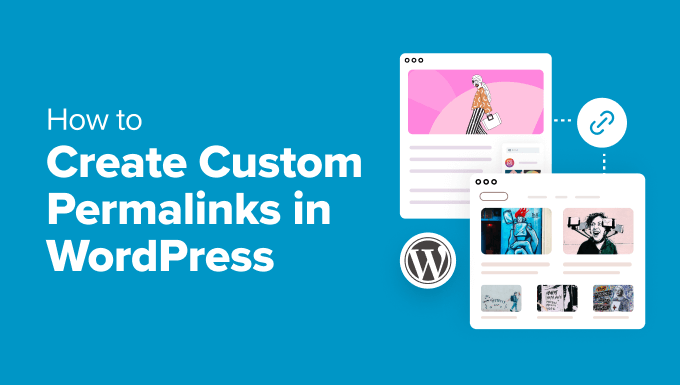
Comme il s’agit d’un tutoriel complet sur la création de permaliens personnalisés dans WordPress, nous avons créé une table des matières facile à parcourir :
- What Is a Custom Permalink in WordPress?
- How to Change the WordPress Permalink Structure
- How to Change the Category and Tag URL Prefix in WordPress
- How to Change an Individual WordPress Post or Page URL
- How to Change a WordPress Category or Tag URL
- How to Change an Author Page URL in WordPress
- How to Create Completely Custom Permalinks in WordPress
- How to Set Up Permalink Redirects and Avoid 404 Errors
- Frequently Asked Questions About Custom Permalinks
Qu’est-ce qu’un Outil de personnalisation dans WordPress ?
Les permaliens sont les URL permanentes de vos publications de blog, pages et autres pages d’archives individuelles sur votre site WordPress.
L’objectif de votre permalien est de créer une structure d’URL facile à comprendre à la fois pour les humains et pour les moteurs de recherche. Voici un exemple :
https://example.com/best-refrigerators-for-tiny-kitchens/
Cette URL est beaucoup plus facile à comprendre que les URL d’autrefois, qui ressemblaient à ceci :
https://example.com/index.php?p=4556
WordPress propose aux propriétaires de sites web plusieurs options de permaliens à choisir. Vous pouvez les voir en visitant la page Réglages » Permaliens dans votre zone d’administration WordPress.
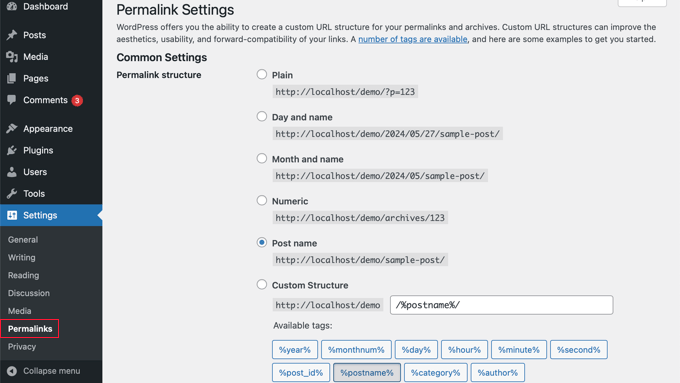
Outre la modification de la structure principale du permalien, WordPress propose également des moyens de personnaliser les URL individuelles des publications, des pages, des catégories, des identifiants et d’autres parties de votre blog.
Vous pouvez également utiliser des extensions WordPress pour créer des permaliens entièrement personnalisés pour des sections spécifiques de votre site, qui surchargent les réglages par défaut de WordPress.
Ceci étant dit, examinons toutes les options une par une. Nous commencerons par les options intégrées par défaut qui sont fournies avec votre site WordPress.
Comment modifier la structure du permalien de WordPress
Si vous souhaitez modifier l’ensemble du schéma de génération d’URL pour votre site, alors rendez-vous sur la page Réglages » Permaliens de votre tableau de bord WordPress que nous avons mentionnée plus haut.
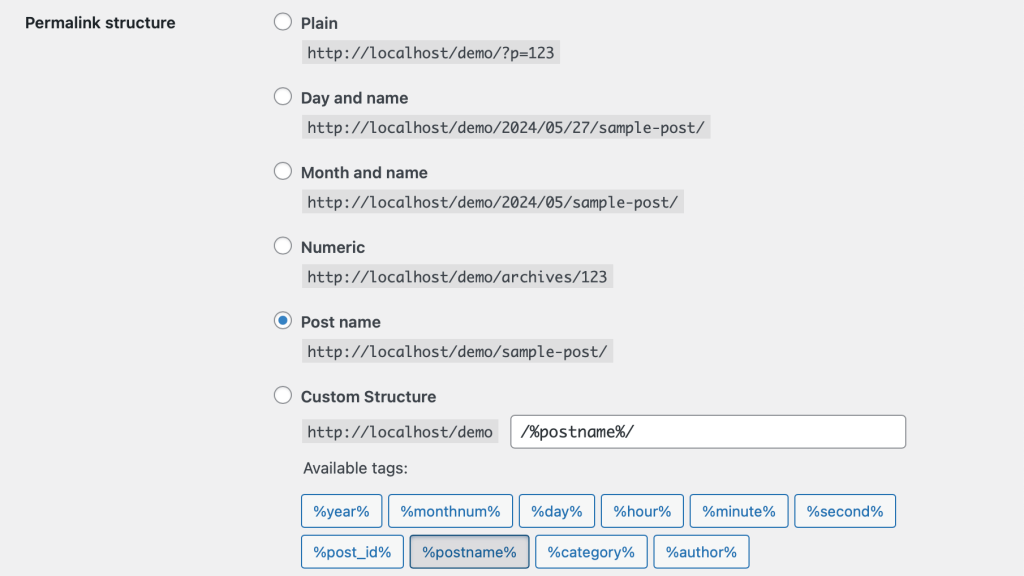
Ici, vous pouvez sélectionner une structure d’URL pour vos publications individuelles. Vous pouvez également utiliser les identifiants affichés à l’écran pour créer une structure personnalisée pour vos URL WordPress.
Par exemple, vous pouvez utiliser le titre de la publication %postname% et la catégorie %category%, ainsi que l’année %year% à laquelle elle a été publiée.
N’oubliez pas de cliquer sur le bouton « Enregistrer les modifications » en bas de la page pour stocker vos modifications.
Nous recommandons d’utiliser une structure d’URL qui inclut le nom de la publication dans l’URL. Cela rend vos URLs plus simples/simple d’utilisation et peut améliorer votre référencement WordPress.
Confirmez l’utilisation de permaliens SEO-friendly comme celui-ci lorsque vous créez un nouveau blog ou site WordPress.
Cependant, si vous avez un site existant qui reçoit déjà du trafic des moteurs de recherche, la modification des permaliens peut nuire à votre classement dans les moteurs de recherche.
Comment modifier le préfixe de l’URL de la catégorie et de l’identifiant dans WordPress ?
Par défaut, WordPress utilise /category/ comme base pour les URL de vos catégories et /tag/ pour les pages identifiées.
Voici quelques exemples :
https://example.com/category/technology/
https://example.com/tag/fintech/
Vous pouvez modifier ces préfixes de base en allant dans Réglages » Permaliens et en saisissant/saisissant simplement de nouveaux préfixes. Par exemple, vous pouvez modifier « catégorie » en « sujets » et « identifié » en « hashtag » comme ceci :

Confirmez-vous que vous avez cliqué sur le bouton « Enregistrer les modifications » pour mettre à jour votre base de catégories et votre base d’identifiants.
Désormais, de nouvelles bases de catégories et d’identifiants sont activées sur votre site, comme celles-ci :
https://example.com/topics/technology/
https://example.com/hashtag/fintech/
Comment modifier l’URL d’une publication ou d’une page WordPress ?
Une fois que vous avez configuré votre structure permalienne initiale, WordPress l’utilisera comme modèle pour tous les liens de votre site.
Cependant, vous pouvez également modifier le slug de l’URL à l’intérieur de la structure de l’URL pour les posts individuels, les pages et les types de posts personnalisés afin de le rendre plus favorable au référencement.
Vous pouvez personnaliser la partie « slug » de l’URL à partir de l’écran de modification de l’article dans l’éditeur de contenu de WordPress.
Si vous créez une nouvelle publication ou une nouvelle page, vous devez d’abord cliquer sur « Publier » ou « Mettre à jour » pour enregistrer votre brouillon.
Ensuite, il suffit de cliquer sur « URL » dans la section Récapitulatif des Réglages de la publication.
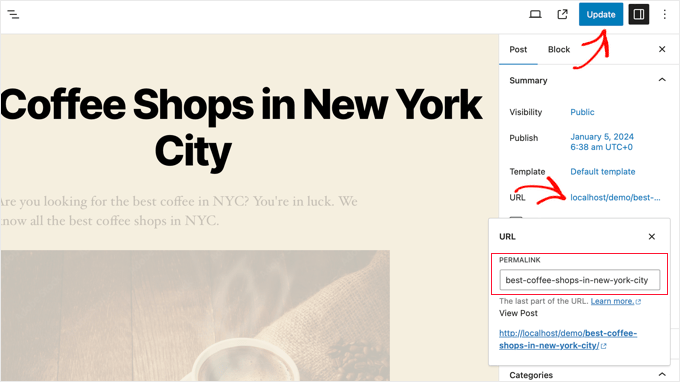
Ensuite, modifiez le slug de l’URL de la publication en un permalien personnalisé.
Une fois que vous avez terminé, cliquez sur le bouton « Mettre à jour » pour enregistrer le nouveau permalien.
Vous pouvez utiliser cette méthode pour tous les types de publication, y compris les produits WooCommerce, les sites d’adhésion, les cours en ligne, etc.
Comment modifier l’URL d’une catégorie ou d’un identifiant WordPress ?
Dans l’étape précédente, nous vous avons affiché comment modifier le préfixe de base des catégories et des identifiants dans WordPress. Dans cette étape, nous allons vous afficher comment modifier les mots-clés de l’URL pour une catégorie ou un identifiant individuel.
Il vous suffit de vous rendre dans la rubrique Publications » Catégories dans votre tableau de bord WordPress, puis de cliquer sur le lien » Modifier rapidement » situé sous la catégorie que vous souhaitez personnaliser.
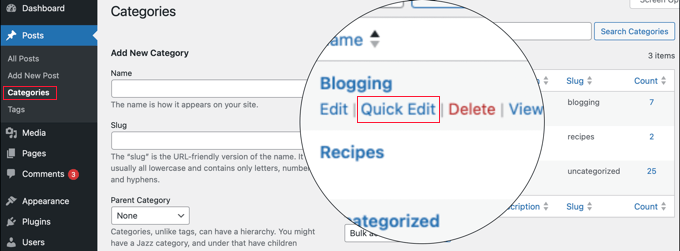
WordPress va maintenant charger les détails de la catégorie.
À partir de là, vous pouvez modifier le slug de la catégorie pour personnaliser son permalien.
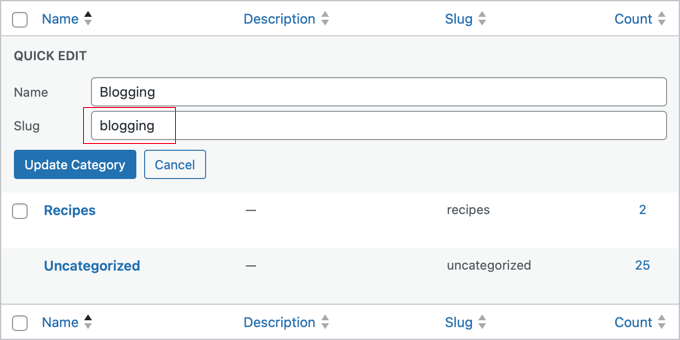
Confirmez-vous que vous avez bien cliqué sur le bouton « Mettre à jour la catégorie » pour enregistrer les modifications apportées aux slugs de la catégorie.
De même, vous pouvez modifier un identifiant individuel en allant dans l’écran « Publications » et en suivant les mêmes étapes.
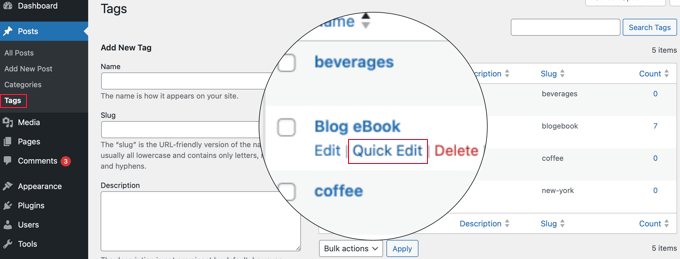
Vous pouvez également modifier toutes les taxonomies personnalisées en utilisant la même méthode que ci-dessus.
Comment modifier l’URL d’une page d’auteur/autrice dans WordPress
WordPress crée automatiquement une page URL d’auteur pour les différents auteurs/autrices de votre site. Les URL des pages d’auteurs/autrices ressemblent à ceci :
https://example.com/author/jsmith/
Dans l’exemple ci-dessus, jsmith est le slug, et auteur/autrice est la base.
Le problème est que WordPress ne propose pas d’option pour modifier la base de l’URL de l’auteur/autrice ou le slug. Modifié, vous pouvez le modifier en quelques clics à l’aide d’une extension WordPress.
La première chose à faire est d’installer et d’activer l’extension Modifier le slug de l’auteur/autrice. Pour plus de détails, consultez notre guide étape par étape sur l’installation d’une extension WordPress.
Une fois activé, allez sur la page Utilisateurs/utilisatrices » Tous les utilisateurs/utilisatrices dans l’administration de WordPress. Ensuite, cliquez sur le lien » Modifier » situé sous l’identifiant.
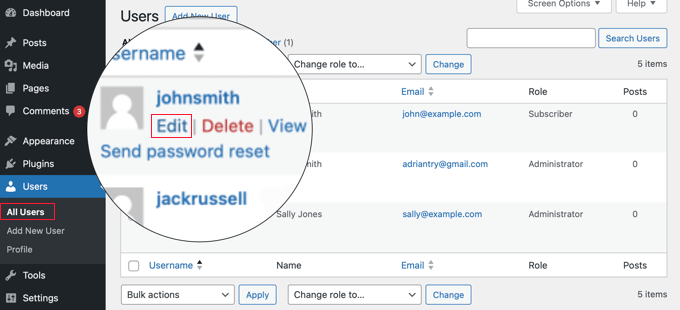
Sur la page suivante, défilez vers le bas jusqu’à la section « Modifier le slug de l’auteur ».
Ici, vous pourrez choisir un auteur/autrice slug ou ajouter le vôtre dans la case « Personnalisé ».
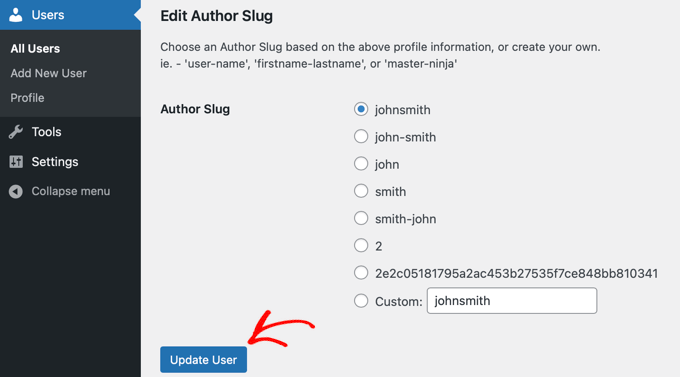
N’oubliez pas de cliquer sur le bouton « Mettre à jour l’utilisateur » pour stocker vos réglages permaliens.
Si vous souhaitez modifier la base du permalien de l’auteur/autrice, il vous suffit d’aller dans Réglages » Modifier le slug de l’auteur.
Vous y trouverez une option permettant de modifier la base d’auteurs et même de choisir des bases d’auteurs différentes pour des utilisateurs/utilisatrices ayant des rôles différents.
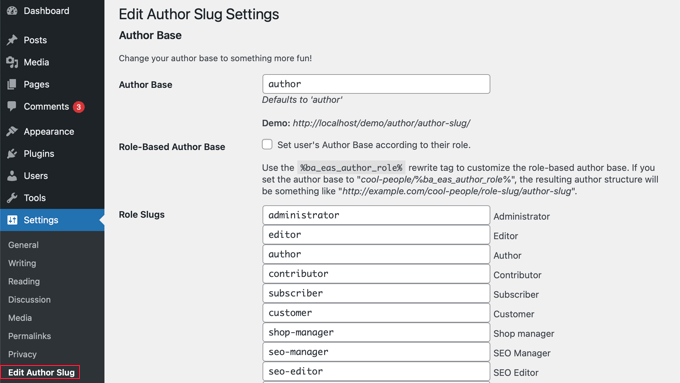
Pour plus de modifications, consultez notre guide sur la modification du slug et de la base de l’URL de l’auteur/autrice dans WordPress.
Comment créer des permaliens complètement personnalisés dans WordPress
Toutes les méthodes ci-dessus vous permettent de personnaliser les permaliens de WordPress dans une certaine mesure. Cependant, elles ne peuvent pas vous aider à créer des permaliens complètement personnalisés.
En effet, WordPress n’offre pas cette fonctionnalité par défaut.
Heureusement, il existe une extension qui peut vous aider. Si vous souhaitez surcharger la structure d’URL par défaut de WordPress pour des sections spécifiques de votre site, ce plugin est fait pour vous.
La première chose à faire est d’installer et d’activer le plugin éditeur/éditrices de permaliens personnalisés. Pour plus de détails, consultez notre guide du débutant sur l’installation d’une extension WordPress.
Une fois activé, vous devez ouvrir la publication dans laquelle vous souhaitez créer un permalien personnalisé.
Ensuite, au lieu de modifier le permalien comme ci-dessus, vous trouverez l’option de créer un permalien personnalisé sous l’éditeur dans la case « Éditeur de permalien personnalisé ».
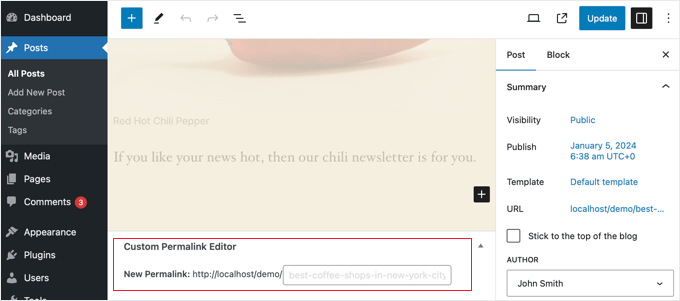
Le permalien personnalisé peut contenir des tirets, des traits d’union ou tout ce que vous voulez. Vous pouvez complètement surcharger la structure permalienne de WordPress. Voici quelques exemples :
https://example.com/seo-friendly-url
https://example.com/seo/friendly/url
https://example.com/seo-friendly/url
De même, vous pouvez créer des permaliens personnalisés pour les catégories.
Pour ce faire, allez sur la page « Messages » « Catégories » et cliquez sur le lien « Modifier » en dessous de la catégorie que vous souhaitez modifier.
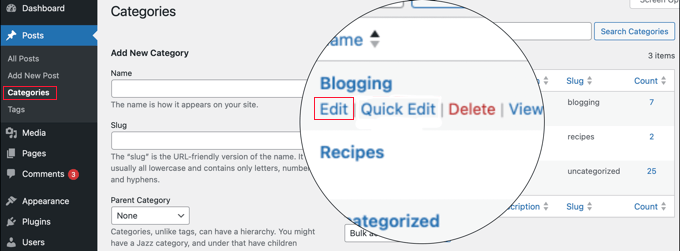
Sur la page des détails de la catégorie, vous trouverez l’option de créer un permalien personnalisé pour cette catégorie particulière.
Vous pouvez même créer une URL sans le préfixe de la base de catégorie.
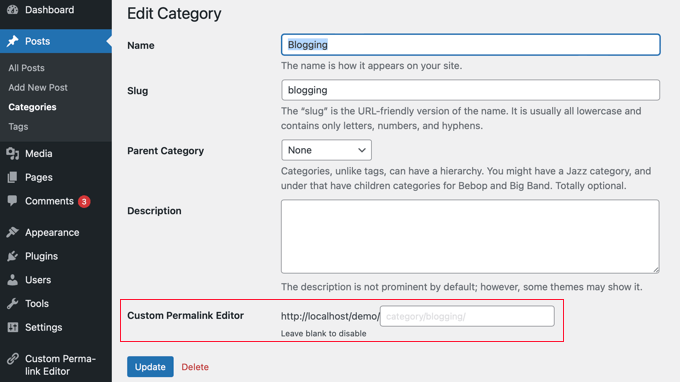
Pour désactiver le permalien personnalisé, il suffit de laisser vide le champ « Editeur/éditrices du permalien personnalisé ».
Ou vous pouvez désactiver tous vos permaliens personnalisés en désactivant simplement l’extension.
Comment configurer des redirections permaliennes et éviter les erreurs 404 ?
Si vous avez apporté des modifications à la structure de vos permaliens ou à votre slug d’auteur, ou si vous avez créé des permaliens entièrement personnalisés, il se peut que vous rencontriez des erreurs 404.
Pour corriger ce problème, vous devez configurer des redirections permaliennes de vos anciens vers vos nouveaux permaliens.
La façon la plus simple de le faire est d’utiliser l’extension All in One SEO. C’est la meilleure extension de référencement WordPress et elle est utilisée par plus de 3 millions de sites pour améliorer leur référencement.
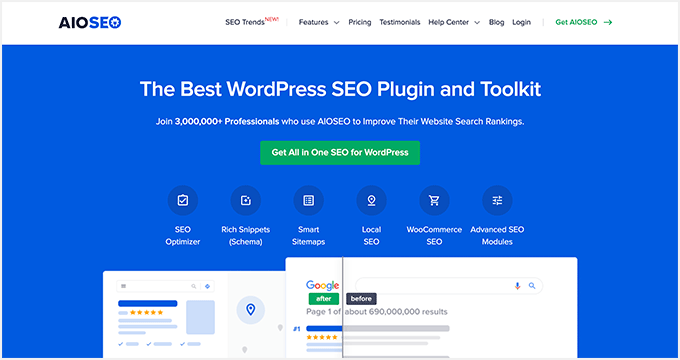
Il dispose d’un puissant module de gestion des redirections qui vous permet de gérer les redirections 301 pour vos permaliens, de suivre et de corriger les erreurs 404, et bien plus encore.
Pour plus de détails sur la façon de configurer les redirections permaliennes, consultez notre guide pour débutants sur la création de redirections 301 dans WordPress.
Une fois activé, vous pouvez gérer et créer de nouvelles redirections permaliennes directement depuis votre Tableau de bord WordPress.

En outre, AIOSEO vous aide également à suivre les pages d’erreur 404 et à les corriger. S’il vous arrive de rater des redirections, cela peut vous aider à les trouver et à les corriger facilement ultérieurement.
Foire aux questions sur les permaliens personnalisés
Maintenant que nous avons abordé la manière de créer des permaliens personnalisés, répondons à quelques questions fréquemment posées sur le Sujet.
Qu’est-ce qu’un permalien dans WordPress ?
Lespermaliens sont les URLs permanents de vos publications, pages et catégories WordPress. Ils déterminent la façon dont votre contenu est affiché dans la barre d’adresse d’un navigateur web et sur les pages de résultats des moteurs de recherche (SERP).
Pourquoi devrais-je créer des permaliens personnalisés ?
Les permaliens personnalisés peuvent être plus simples/simples d’utilisation et plus favorables au référencement. Ils peuvent aider les gens à comprendre le contenu de votre publication à partir de l’URL elle-même. Ils peuvent également améliorer le classement de votre site dans les résultats de recherche.
Puis-je modifier le permalien d’une seule publication ?
Oui, vous pouvez modifier le permalien de chaque article individuellement à partir du panneau des Réglages de l’éditeur de blocs de WordPress.
Quelle est la structure permalienne la plus favorable au référencement ?
La structure la plus recommandée est l’option « Nom de la publication ». Cette structure crée des URL qui utilisent le titre de la publication. Cela est plus facile à comprendre pour les humains et est favorisé par les moteurs de recherche.
Que deviennent mes anciens permaliens si je modifie la structure ?
Lorsque vous modifiez la structure des permaliens, les URL de toutes vos publications et pages existantes sont également modifiées. Cela peut affecter votre Réglage si vous ne configurez pas de redirections 301.
Dois-je configurer des redirections si je modifie la structure ?
Oui. Nous vous recommandons vivement de configurer des redirections pour que les utilisateurs et les moteurs de recherche atterrissent sur les bonnes URL après la modification. Des extensions comme All in One SEO et Redirection peuvent vous aider à gérer facilement les redirections.
Nous espérons que cet article vous a aidé à apprendre comment créer des permaliens personnalisés sur WordPress. Vous pouvez également consulter notre guide sur la façon d’ajouter des mots-clés et des méta descriptions dans WordPress ou nos choix d’experts des meilleurs outils de vérification des backlinks pour voir qui crée des liens vers votre site.
Si vous avez aimé cet article, veuillez alors vous abonner à notre chaîne YouTube pour obtenir des tutoriels vidéo sur WordPress. Vous pouvez également nous trouver sur Twitter et Facebook.






Syed Balkhi
Hey WPBeginner readers,
Did you know you can win exciting prizes by commenting on WPBeginner?
Every month, our top blog commenters will win HUGE rewards, including premium WordPress plugin licenses and cash prizes.
You can get more details about the contest from here.
Start sharing your thoughts below to stand a chance to win!
Jiří Vaněk
I knew some of the settings from WordPress, but some I didn’t even know could be adjusted like this. For example, changing the author URL with a permalink looks great. Is it possible to do this other than using a plugin? I would like to avoid a lot of plugins.
WPBeginner Support
While possible it is difficult which is why we recommend the plugin, for your concern on the number of plugins we would recommend taking a look at our article below:
https://www.wpbeginner.com/opinion/how-many-wordpress-plugins-should-you-install-on-your-site/
Administrateur
Jiří Vaněk
I read the article. I currently have around 30 plugins and it feels like a lot for me. Although I have my own server with 8GB of ram for one website, I try to use some kind of compromise even with regard to WordPress updates. The fewer plugins, the less chance something will break when you update. But I understand. Thank you for answer.
Tasin
Bro I do not have the permalink editor in the post editor sidebar. Why is that? I am using the latest version of WordPress. I can edit url in classic editor but not in block editor.
WPBeginner Support
We would recommend checking your preferences in the post editor to ensure you do not have that section hidden as a likely reason.
Administrateur
Robert
After adding the link to subcategories, WP changes to: /?product_cat=
How is it possible to change it?
WPBeginner Support
That looks like you are using an eCommerce plugin, you would want to check further down the permalinks page or in the plugin’s settings for modifying those permalinks.
Administrateur
Vivek
Hello,
To rank my news website on Google News, do I need to use the permalink link Iike postname-postID?
Because I see most of the news website uses this format?
WPBeginner Support
While not required, that is the normal preferred permalink setting.
Administrateur
Jacob Corbett
Hi WP Beginner,
Great article! I have already made multiple pages with a theme and I want to change all their permslinks. Every time I do it I get a 404 on the updated page.
WPBeginner Support
You would likely need to resave your permalink settings and redirect your old posts/pages if you wanted.
Administrateur
Haseeb Nazir
Hi,
If we use custom permalink plugin does it affect our website SEO in any case?
WPBeginner Support
It would depend on what you do with the plugin, using the plugin to make the same change you would do manually would not be different than using the plugin if that is what you mean
Administrateur
Katie
I see that this post was originally from 2016. Would you still recommend using Custom Permalinks as the plugin for this? When i went to add the plugin it says « Untested with your version of WordPress » and the last update was a year ago. Would love to know if this is still recommended.
WPBeginner Support
For that not tested warning, you would want to take a look at our article below for our opinion on that:
https://www.wpbeginner.com/opinion/should-you-install-plugins-not-tested-with-your-wordpress-version/
Administrateur
A K P
Hi,
I have old website and now I change my Permalink Settings setting from date pattern to post name.
will it change old links too?
Site is performing good in google. I don’t want to change old setting.
But new post with Post name Permalink Settings.
WPBeginner Support
The link to the post itself would change but links to the post at the old location would not update and would cause 404 errors for anyone using those links.
Administrateur
swati
really helpful very very thanks.
WPBeginner Support
You’re welcome
Administrateur
WONDER APATI
Hello, I read your post on how to migrate from blogger to WordPress. One of the things that I see as the issue here is the link structure and AdSense.
Assuming that I migrate from blogger to WordPress without setting the link to month and day as you recommended in the other post but rather choose to edit each post I migrated from blogger to match the month and day, will that work?
Otherwise, all other posts I published will maintain the posts URLs except those imported from blogger(they would be edited to match the month and day) will that be ok
WPBeginner Support
If you change your permalinks then you would need to create redirects to prevent your visitors from seeing 404 errors.
Administrateur
Yolandie
Thank you so much for the help. Building my page day by day and these info help lots
WPBeginner Support
Glad our guides can help
Administrateur
Adhyansh Jadli
Thank you very much for such a nice article. I was finding way to set up categories and tags. I am regular follower of your blog and youtube channel.
It is the best platform i had ever seen, which provide detailed info for newbie like me.
You helped me to setup my wordpress.
Thanks a lot SYED BALKHI sir
Adhyansh Jadli
WPBeginner Support
You’re welcome, glad our content can be helpful
Administrateur
Pawan Khadka
Is there any post that guide me to create query based url example :
Main Content: example.com/this-is-my-post (Page With main content)
Download page: example.com/this-is-my-post?download (page with download links)
WPBeginner Support
Unless I hear otherwise, we do not have a recommended method to set up that kind of permalink
Administrateur
Couper
Is there any way to remove the /home from the end of my URL without plugins on the Premium version?
WPBeginner Support
If you mean it is on every page then you would want to take a look at: https://www.wpbeginner.com/wp-tutorials/how-to-get-rid-of-wordpress-from-your-wordpress-site-url/
Administrateur
Marina28
What can we do for the urls tha are not post and pages for example in a forum plugin that I embed I can not edit the urls for it. There is any file in wordpress that I can edit each one url ??
WPBeginner Support
You would want to reach out to the support for that specific plugin for how to modify the permalinks for its additions.
Administrateur
Ferdin Norbert
Hi, Nice post. Currently, I am working on a project where I wanted to change an in built tab called promotions and I did this programmatically, I was successful in renaming the promotions tab to Notification tab. But the only thing left is its permalink. I want to change MyAccount/Promotions to MyAccount/Notifications. Is there any way to achieve this? Please reply as soon as possible.
Thank you
WPBeginner Support
It would depend on what is creating the account, if you reach out to the support for the plugin you are using they should be able to let you know.
Administrateur
Quy
Excellent article!
WPBeginner Support
Thanks!
Administrateur
ASHOK KUMAR SONAWAT
Thanks today my problem is solved after reading this article…
WPBeginner Support
You’re welcome
Administrateur
Alex Hoyle
Hello. I just made a WordPress website for my blog. How do I change the permalink to use the primary domain instead of starting with the temp.domain?
WPBeginner Support
You would want to check under Settings>General to see what your domain is set as, if it is on your temporary domain there then normally you can reach out to your hosting provider to help you update from your temporary domain to the correct address without issue
Administrateur
The Thus
Hello WPBeginner,
I have configured and setup as you have shown in article but still my articles are ranking in Google domain.com/category ,may I know how to solve this issue ??
WPBeginner Support
Google may have cached the old structure if you changed it. You could use Google’s URL removal tool if you wanted to remove those results in Google search.
Administrateur
Geet
I want to structure my new website like this –
my-company.com/main-page
my-company.com/main-page/supporting-article-1
my-company.com/main-page/supporting-article-2
my-company.com/main-page/supporting-article-3
Is it possible to create this structure using Custom Permalinks plugin?
WPBeginner Support
The plugin should allow you to change the permalink to anything so it should be able to set up that permalink structure.
Administrateur
Mike Coleman
I have a new website (unpublished as yet) and want to have a home page. However, when I attempt to create a page with just that URL Permalinks adds an unfathomable number to the URL eg – example.com.au/123-2.
I’ve tried altering the Permalink settings but that alters the code after the / to whatever the settings dictate.
How do I create a page with just the URL and no / or additions after the /?
regards
Mike
WPBeginner Support
If you want to have a specific page appear when it is just the url without the slashes then you would set the home page under Settings>Reading
Administrateur
Geetanjali
Hi I have shifted my blog from blogger to wordpress. My permalink set to month and post. But now for new post I want the permalink to be post only. So after reading this aricle I have installed custom permalinks plugin but while editing the new post I don’t see the option to change the month and post from slug. Please suggest what can be done for changing the new post and coming post permalink to post only instead of month and post.
Tucker Daugh
I’ve been told by developers to not change permalinks at the « EDIT » level. I have some pages on a site I helped build that really could benefit with a name change. Something that reflects what a person may be searching for vs something we were trying to be clever with. So, question: What causes permalinks to « break » if you change them at that edit stage (When you open a page and see the URL). I would assume if I am careful and do_something_like_this than I’m okay, right?
WPBeginner Support
Hi Tucker,
When you change a page’s URL by editing it, your page would work fine on your website. However, your old URL would be indexed by search engines and they will not be able to find it. If you must change the permalink of an existing page, then you need to set up a redirect.
Administrateur
Talkgeria
Thanks for sharing this helpful post.
My problem is that my blog posts shows mysite.com/category instead of mysite.com/postname on search result but shows the post name once you click on it. my question now is, how do i make the post name to appear on search result as well?
kenneth khayyam
nice article very helpful for beginners
Vidya
Hi
i have a page which compares different products. permalink of the same is /page-name/?compareids=1,2,3
can you please suggest me about how to customize permalink of this kind of pages so to display permalink like : /page-name/compare-productname1-vs.-productname2-vs.-productname3
Prashant Chevale
Hello Team,
I have an query,
1.How to implement keywords in url before creating post & after creating post?
2.How to implement keywords in Posts url without creating 404 error in WordPress?
3. Without creating 404 error how to optimise urls?
4.I want permalink customise ( insert keyword in url ) without any error how can I set that?
please help me…
Thank you.
Orit Adar
My entire site is still under maintenance, but most of my posts are defined as « published » in that setup. If I want to change the slugs can I just revert the status to « draft » temporarily, change the slug and then re-« publish »? I guess I do not understand the meaning of the word « publish » as long as the site is not alive, but it helps to see the posts better s I did it. Thank you.
WPBeginner Support
Hi Orit,
If your site is not live and your content is not indexed by search engines, then you can change the slug of a live page/post as well.
Administrateur
Adell
My site is new and under construction -not live. I’ve created a couple posts and published them, but my site is not live. Can i keep changing the slug , permalinks, and category tags, without needing the re-direct plug in?
Is it safe to keep making changes to the permalink as long as my site is not live (even though i clicked ‘publish’?
Do i only need the redirect plug in if i make changes tot the permalnk after the site goes live?
thank you!!
Nnamdi
I would like to know how to create a page name before the website url example customname.yoursitename.com. i don’t know how else to describe this sorry for any misunderstanding.
WPBeginner Support
Hi Nnamdi,
These are called subdomains. They are not like pages at all. In fact, a subdomain could be a totally different website using the same root domain name.
Administrateur
Brandy
Hi, when a do this process, the /blog does not appears in the breadcumbs. What can I do?
I want my blog:
example.com/blog/category/post-1
and the breadcumbs:
Home > Blog > Category > Post-1
How can I add the > Blog to my breadcumbs?
I guess it does not appear because / blog is artificially configured. Is there any way to make it hierarchical?
Jaymi V
My permalink structure is set to post type. After I have published a page & I parent it in order to use the parent’s sidebar menu, once I update the page it adds another link to the url structure — for example, page url originally is: example.com/acctg/new-page
After I parent it to my accounting landing page & I update the page the url becomes:
example.com/acctg/accounting/new-page
If I delete the extra /accounting from the permalink the page will appear as a blank page unless I un-parent it from /accounting landing page & create its own sidebar menu.
Is there a workaround to this problem?
Francis
Please, I added post I’d in my post permalink. But i want to change my permalink structure to /category/post_name but am afraid the old link will be down and this might make me loose my Google ranking.
I want to change the post ID *956* to category of the post. But how can i redirect the old URL to the new one after the changes is done? Please help me.
Hassanein
Hi, thanks for the Useful article, I have a question, in my WordPress blog when I press on the post title it gives me the correct permalink (Post name only), but when I press on the (continue reading ) it gives the same permalink but with some extra codes! How can I make it similar without more extension! Only the post name without any additions ?
Valente
Hello, I already have a worpress website and I am using a theme with home,page, about us etc. I added woocommerce where woocommerce has its own permalinks structure,My WP permalinks are set for static page %post%
the woocommerce shop it is not the home page …
Should I leave the wp permalinks as it is ? And how should i have to set the woocoommerce permalinks and reading?
WPBeginner Support
Hey Valente,
WooCommerce will not affect your website’s permalink structure.
Administrateur
AmeerTarin
Good evening,
I have a website up and running for several years. Now I want to use the WordPress generated permalink for my page to publish article(s). I have .htacess & index.php in place. Now the question? How do I use my custom permalink for new page? Do I copy the link & paste it in the address bar. Or how does it work? I am stuck at this last bit. Please help. Many thanks
Ameer
balu
Is there no way of creating custom permalinks without a plugin.
Donna
Without the plugin, the slug always has a “-2” at the end, as if it were a copy. But with the plugin.it will not has a « -2 ». How can I do
Dor
Hi
If I change the title of a static home page, should it affect the URL?
WPBeginner Support
Hi Dor,
If you have published the homepage, then it will not affect the URL. However, if the page is still saved as a draft and has never been published, then changing the title will change the URL slug. However, you can click on the URL slug on the page edit screen and change it back.
Administrateur
Carlos
Thank you for this!!
Karunakar
How to add prefix or suffix to permlink of all post_tag slugs?
Ayumi Higashi
I do not see the edit bottom to change perm links on post pages…why?
Hannen
I want to get get rid of the permalink altogether. I don’t want the titles to have a link. Is there a way to do that?
Thank you
WPBeginner Support
Yes, however most WordPress themes are designed to have permalinks. You will probably need to create a custom theme that meets your needs or customize an existing starter theme.
Administrateur
Hannen
Thanks! I already thought I chose a simple lay out(‘Maker’) but I will look into the starter themes.
Ravi
Please help me,
I want permalink like this
example.com/category/post_name
How can I set that?
please help me…
Sue Jonas
I have a newly built site and all the permalink options look like this: example.com/wordpress/xyz options
I can’t find a one without ‘wordpress’ in the middle. Have I done something wrong? How can I fix this? Thank you
WPBeginner Support
Please see our guide on how to get rid of /wordpress/ from your WordPress site URL.
Administrateur
Jean-Francois Mayer
Thank you. This is indeed a good description. However, there is one aspect that you do not mention: what happens to the customized slugs in case the permalink structure changes.
I am currently moving a website in French to WP. When titles are too long, or include apostrophes (that result into making two words into one, when slugs get automatically created), I have shortened them.
After a number of my customized permalinks had been created, I decided that I preferred the permalinks to follow a structure on the pattern year-month-day, i.e…./2016/08/15/… instead of …/2016/08/…
Easily done… but all my customizations were gone!
I will recreate them. But then, how to make sure that my customized permalinks will stick, even if I would decide to change again the permalink structure before the site goes live?
There should be a way, or a plugin – but I have not yet found it.
WPBeginner Support
Slugs are not supposed to be changed when you update permalink structure. They are stored in the database and will be used again when you use a Permalink structure that uses post-name in the URL instead of ID.
Administrateur
Jean-Francois Mayer
Thank you very much for your reply.
Yes, I expected indeed custom slugs not to change when I updated the permalink structure… but they did, for reasons beyond my understanding, and I do not dare to test that a second time. It may have to do with the fact that a number of posts were imported from another CMS in an automated way, which resulted in numeric slugs, that we managed to regenerate (using Permalink Manager) in order to bring them to standard slugs. Maybe this had unexpected consequences when changes in settings were made at a later stage.
Anyway, good to know this is not a frequent behavior, and probably caused by something else. But I will be extremely careful in the future with any change in the permalink structure!
Logen
The recent low ratings, inactive support forums and lack of response from author is making me hesitant to use Custom Permalinks. Anyone has any issues with it, considering last plugin update was 7 months ago?
nate
It was now updated 1 month ago
mansuri
superb post sir
Aseel
Great articel
Thanks
Stefano
Really interesting. Many thanks for the good stuff. I’ll give a try for sure as I have to manage categories, sub-categories and a lot of tags.